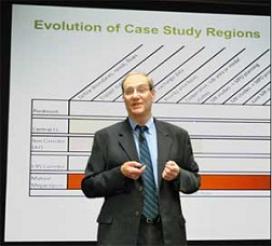The Challenge of Transportation Planning for Megaregions
Transportation planning in the United States is facing a compelling need to add a significant focus to meet the growing demands of "megaregions." According to the Center for Quality Growth and Regional Development, megaregions are typically defined as "large networks of metropolitan centers and surrounding areas connected through cultural, environmental, [and] economic characteristics, as well as infrastructure," said William Lyons, principal technical advisor for transportation planning at Volpe, The National Transportation Systems Center.
Lyons spoke about the challenges associated with planning for megaregions (view presentation) in the United States during a recent lecture at Volpe.
There are currently 11 accepted major megaregions in the U.S., including areas that cover Northern and Southern California, the Arizona Sun Corridor, and the Texas Triangle, and several that cross into multiple states or cross international borders. These areas have major transportation needs but lack institutions that are responsible for planning transportation investments or strategies to meet these needs.
Lyons cited many important reasons why we should turn our attention to planning for megaregions. Megaregions are the logical planning areas for pursuit of global economic opportunities. They improve freight and logistic flows to and from ports, beyond the limits of legally defined borders.
"What would a successful mega-regional planning process look like?" asked Lyons. Key principles would include a systems approach to transportation with integrated, multimodal, and intermodal components and a "3-C" process of continuing, comprehensive, and cooperative planning.
State Departments of Transportation and Metropolitan Planning Organizations (MPOs) follow these principles in planning for states and metropolitan areas nationwide. In the absence of similar formal institutions responsible for planning for megaregions, the planning can be ad hoc, fragmented, and dependent on the willingness and ability of cities, regions, rural areas, and states to look beyond their boundaries.
Megaregion planning is occurring, said Lyons, but only to a limited degree. Major challenges exist, as megaregion planning processes take a long time. Early initiatives do not make it to the final phases with agreement on investments or strategies to address transportation needs. Lyons also pointed out the problem of leadership turnover: continuity issues between administrations make it difficult to carry through on large-scale plans with long-time horizons.
Megaregion planning is a core topic for Volpe, focusing initially on the role of MPOs and their partners, innovations, and best practices. Volpe tackles a broad range of megaregion projects, including research and case studies on urban and rural areas, organizing a national experts' workshop, developing white papers, and providing support to megaregions research groups, including through the Transportation Research Board.
Lyons finished his talk by identifying the importance of having a champion to undertake early stages of megaregions planning, as new leaders come into office. He shared his enthusiasm and vision for the newest case studies, which demonstrate the potential value of applying comprehensive planning frameworks for megaregions.

